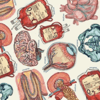Podcast
Questions and Answers
What is the primary function of the hormones produced by follicular cells in the thyroid gland?
What is the primary function of the hormones produced by follicular cells in the thyroid gland?
- Regulation of blood glucose levels
- Regulation of metabolism and energy production (correct)
- Production of thyroid-stimulating hormone
- Regulation of calcium homeostasis
Which condition is characterized by excessive production of thyroid hormones?
Which condition is characterized by excessive production of thyroid hormones?
- Hyperthyroidism (correct)
- Hypothyroidism
- Thyroiditis
- Hashimoto's disease
Which thyroid-related marker is most relevant in monitoring thyroid cancer?
Which thyroid-related marker is most relevant in monitoring thyroid cancer?
- Calcitonin
- Thyroxine (T4)
- Tri-iodothyronine (T3)
- Thyroglobulin (correct)
Which antibodies are often assessed in the diagnosis of autoimmune thyroid disease?
Which antibodies are often assessed in the diagnosis of autoimmune thyroid disease?
How does estrogen affect thyroid function?
How does estrogen affect thyroid function?
What role do thyroid hormones play in the cardiovascular system?
What role do thyroid hormones play in the cardiovascular system?
Which of the following is a function of thyroid hormones during childhood?
Which of the following is a function of thyroid hormones during childhood?
How are thyroid hormone levels primarily controlled?
How are thyroid hormone levels primarily controlled?
What is a common symptom of hyperthyroidism?
What is a common symptom of hyperthyroidism?
What effect do thyroid hormones have on muscle fibers?
What effect do thyroid hormones have on muscle fibers?
In adults, thyroid hormones affect mood by:
In adults, thyroid hormones affect mood by:
What is the relationship between thyroid hormones and fertility?
What is the relationship between thyroid hormones and fertility?
What does a low blood concentration of free T4 or T3 trigger?
What does a low blood concentration of free T4 or T3 trigger?
What is the primary form of thyroid hormone secreted by the thyroid gland?
What is the primary form of thyroid hormone secreted by the thyroid gland?
Which of the following statements about T3 and T4 is TRUE?
Which of the following statements about T3 and T4 is TRUE?
How is the production of T3 affected by systemic illness?
How is the production of T3 affected by systemic illness?
Which factor is NOT known to increase the conversion of T4 to T3?
Which factor is NOT known to increase the conversion of T4 to T3?
What is the main biologically active form of thyroid hormone?
What is the main biologically active form of thyroid hormone?
What role does thyroglobulin play in the synthesis of thyroid hormones?
What role does thyroglobulin play in the synthesis of thyroid hormones?
In what way does estrogen potentially impact thyroid function?
In what way does estrogen potentially impact thyroid function?
What is the percentage of free T4 in plasma that is biologically active?
What is the percentage of free T4 in plasma that is biologically active?
Which of the following is a physiological effect of thyroid hormones?
Which of the following is a physiological effect of thyroid hormones?
Flashcards
Thyroid Hormone Function
Thyroid Hormone Function
Thyroid hormones affect virtually every organ system, influencing metabolism, bone growth, brain development, fertility, and more.
Thyroid Hormone's Permissive Effect
Thyroid Hormone's Permissive Effect
Thyroid hormones increase the response of other hormones, in this case, catecholamines, leading to enhanced effects like increased heart rate and contractility.
Thyroid Hormone Effect on Heart
Thyroid Hormone Effect on Heart
Thyroid hormones increase heart rate, stroke volume, cardiac output, and contractility by increasing beta-receptor expression.
Thyroid Hormone Effect on Muscles
Thyroid Hormone Effect on Muscles
Signup and view all the flashcards
Thyroid Hormone in CNS development
Thyroid Hormone in CNS development
Signup and view all the flashcards
Thyroid Hormone Effect on Metabolism
Thyroid Hormone Effect on Metabolism
Signup and view all the flashcards
TRH (Thyrotropin-Releasing Hormone)
TRH (Thyrotropin-Releasing Hormone)
Signup and view all the flashcards
TSH (Thyroid-Stimulating Hormone)
TSH (Thyroid-Stimulating Hormone)
Signup and view all the flashcards
Negative Feedback Control (Thyroid)
Negative Feedback Control (Thyroid)
Signup and view all the flashcards
Thyroid Gland Structure
Thyroid Gland Structure
Signup and view all the flashcards
Thyroid Follicles
Thyroid Follicles
Signup and view all the flashcards
Follicular Cells
Follicular Cells
Signup and view all the flashcards
Thyroid Hormones
Thyroid Hormones
Signup and view all the flashcards
Parafollicular Cells (C-cells)
Parafollicular Cells (C-cells)
Signup and view all the flashcards
Calcitonin's Function
Calcitonin's Function
Signup and view all the flashcards
Thyroid Hormone Synthesis
Thyroid Hormone Synthesis
Signup and view all the flashcards
T4 and T3
T4 and T3
Signup and view all the flashcards
Peripheral Conversion of T4
Peripheral Conversion of T4
Signup and view all the flashcards
Plasma Binding of TH
Plasma Binding of TH
Signup and view all the flashcards
Free T4 and T3
Free T4 and T3
Signup and view all the flashcards
Effects of Thyroid Hormones
Effects of Thyroid Hormones
Signup and view all the flashcards
Basal Metabolic Rate
Basal Metabolic Rate
Signup and view all the flashcards
Factors affecting T4 to T3 conversion
Factors affecting T4 to T3 conversion
Signup and view all the flashcards
Study Notes
Thyroid Disorders & Thyroid Function Test
- Thyroid disorders are categorized as hyperthyroidism (excess thyroid hormones) and hypothyroidism (deficiency of thyroid hormones).
- An underactive thyroid can lead to mild fatigue.
- Individuals experiencing cognitive issues, mood swings, memory problems, or attention difficulties may have a thyroid issue.
- The thyroid gland is a butterfly-shaped endocrine gland located in the lower front of the neck.
- A healthy thyroid typically weighs approximately 30 grams.
- The thyroid gland is highly vascularized, receiving 80-120 mL of blood per minute.
Objectives
- Describe the structure and function of the thyroid gland.
- Explain the function of thyroid hormones.
- Outline the action of thyroid hormones.
- Outline the control of thyroid hormone secretion from the thyroid gland.
- Describe conditions leading to abnormal thyroid hormone production (hyperthyroidism and hypothyroidism).
- Discuss the investigation of suspected thyroid dysfunction.
Thyroid Gland Structure
- The thyroid gland is butterfly-shaped.
- It's composed of two lobes connected by an isthmus.
- The thyroid cartilage of the larynx, hyoid bone, common carotid artery, internal jugular vein, trachea, clavicle, and sternum surround the gland.
Microscopic Anatomy
- The thyroid gland has small, spherical sacs called thyroid follicles.
- Follicle walls primarily consist of follicular cells.
- Follicular cells produce thyroxine (T4) and triiodothyronine (T3).
- These hormones are jointly known as thyroid hormones.
- Parafollicular cells (C-cells) are interspersed between follicles.
- C-cells produce calcitonin, a hormone regulating calcium homeostasis.
Thyroid Hormones
- Thyroid hormones (TH) are synthesized by the thyroid gland via iodination and coupling of tyrosine molecules attached to thyroglobulin.
- T4 contains four iodine atoms; T3 contains three iodine atoms.
- Thyroxine (T4) is the major hormone secreted.
- T3 is the biologically active form, produced primarily by the conversion of T4 in peripheral tissues.
- Approximately 80% of plasma T3 arises from peripheral deiodination of T4.
- TH synthesis involves several steps, including iodide transport, tyrosyl residue iodination within thyroglobulin (Tg), coupling of iodotyrosines to form T4 and T3, proteolysis of Tg, release of free T4 and T3, and transport into the blood.
- T4 and T3 are lipid-soluble and are primarily bound to specific proteins in plasma (TBG, prealbumin, albumin), which render them water-soluble, reducing renal loss and providing a large pool, while protecting cells from the hormones' physiological effects.
- The unbound/free forms are biologically active.
- Typical reference ranges for serum total and free T4 and T3 levels vary between labs.
Peripheral Conversion of Thyroid Hormone
- 20% of T3 is secreted by the thyroid gland.
- 80% is produced enzymatically in non-thyroidal tissues by removing an iodine atom from the outer ring of T4.
- T3 is the body's main active form, binding more readily to thyroid receptors.
- The conversion of T4 to T3 can be affected by factors like systemic illness, prolonged fasting, and certain medications (beta-blockers).
- Conversion of T4 to T3 can increase with medications that induce hepatic enzyme activity (e.g., phenytoin).
Physiological Effects of Thyroid Hormones
- Thyroid hormones (TH) primarily influence metabolism, growth, and development, particularly in children.
- They increase basal metabolic rate (60-100%).
- TH influences the metabolism of proteins and carbohydrates.
- In children, THs synergistically act with growth hormone in stimulating bone growth; they affect chondrocyte, osteoblast, and osteoclast activity.
- They contribute to brain maturation, promoting axonal growth and myelin sheath formation.
- THs impact fertility, ovulation, and menstruation.
- Thyroid hormones affect virtually every organ system in the body, impacting the heart, Central Nervous System (CNS), autonomic nervous system, bone, Gastrointestinal (GI) tract, and overall metabolism.
Thyroid Function Tests (TFTs)
- TFTs are a collective term for blood tests to assess thyroid function.
- Key tests include TSH, T4, T3, Thyroid peroxidase antibodies (TPO Ab), thyroglobulin antibodies (Tg Ab), and Thyroid stimulating hormone receptor antibodies (TR Ab).
- TSH levels, T4, and T3 have specific reference ranges that vary between labs, crucial to interpret results.
- T3 measurement is not a routine requirement for most scenarios, but it can be useful in diagnosing T3-toxicosis when other parameters are normal.
Disorders of Thyroid Function: Classification
- Disorders are classified broadly as hyperthyroidism (excess thyroid hormones) and hypothyroidism (deficiency of thyroid hormones).
Hypothyroidism
- Symptoms include intolerance to cold, receding hairline, facial/eyelid edema, dull expression, extreme fatigue, thick tongue, slow speech, anorexia, brittle nails, hair, menstrual irregularities, subnormal temperature, bradycardia, weight gain, and thickened skin.
- Diagnosis often includes assessing TSH and free T4.
Investigation & Diagnosis (for Hypothyroidism)
- Routine assessment involves measuring TSH and free T4.
- A rise in TSH is often observed with declining thyroid hormone levels.
- T3 levels are sometimes measured for evaluation but are not routinely needed
- Primary hypothyroidism (e.g., Hashimoto's thyroiditis) shows elevated TSH, and low free T4.
- Secondary hypothyroidism indicates a pituitary or hypothalamic issue with inappropriately low TSH levels and low free T4.
Investigation & Diagnosis (for Hyperthyroidism)
- Hyperthyroidism is diagnosed with suppressed or undetectable TSH levels and raised T3 and T4 values.
Case Studies
- Illustrative patient cases show how thyroid hormone tests (measurements of TSH and free T4 and T3) inform diagnosis and treatment.
- Case study patients may experience a variety of symptoms (weight gain, constipation, weakness) or (increased heart rate, nervousness).
- Treatment success is indicated by the normalization of thyroid function test results.
Euthyroid Goiter
- Enlargement of the thyroid (goiter) despite normal levels of thyroid hormones.
- Often result of persistent TSH stimulation, potentially due to iodine deficiency hindering hormone synthesis.
Non-thyroidal Illness
- Certain severe illnesses (e.g., myocardial infarction, sepsis) can cause abnormal thyroid function test results in the absence of thyroid pathology.
- These abnormalities are often characterized by suppressed TSH, low total and free T3, and sometimes, low T4 levels, especially during the acute stages.
- During recovery, the values typically return to normal.
Interpretation of TFTs
- Pregnancy impacts TFT results due to elevated TBG; this increase doesn't change the level of free T4.
- Hyperemesis gravidarum can produce a temporary thyrotoxicosis-like syndrome characterized by high free T4 and free T3 due to severe vomiting.
- Other factors influencing TFT interpretations include severe illness and medications like androgens or danazol.
Thyroxine-binding Globulin (TBG)
- TBG is a protein that binds to and transports thyroid hormones in the bloodstream.
- In normal conditions, 1/3 of TBG binding sites are occupied.
- Elevated TBG levels may be caused by estrogen in pregnancy.
- Decreased TBG levels can be caused by illness or certain medications.
Studying That Suits You
Use AI to generate personalized quizzes and flashcards to suit your learning preferences.





